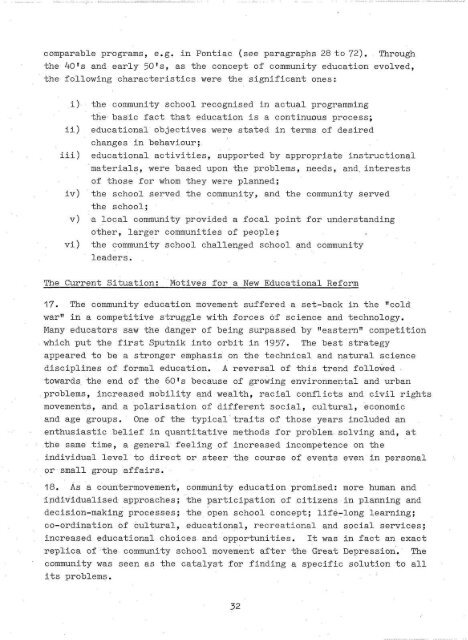BUILDING FOR SCHOOL AND COMMUNITY - Kennedy Bibliothek
BUILDING FOR SCHOOL AND COMMUNITY - Kennedy Bibliothek
BUILDING FOR SCHOOL AND COMMUNITY - Kennedy Bibliothek
Create successful ePaper yourself
Turn your PDF publications into a flip-book with our unique Google optimized e-Paper software.
comparable programs, e.g. in Pontiac (see paragraphs 28 to 72). Through<br />
the 40's and early 50's, as the concept of community education evolved,<br />
the following characteristics were the significant ones:<br />
i) the community school recognised in actual programming<br />
the basic fact that education is a continuous process;<br />
ii) educational objectives were stated in terms of desired<br />
changes in behaviour;<br />
iii) educational activities, supported by appropriate instructional<br />
materials, were based upon the problems, needs, and( interests<br />
of those for whom they were planned;<br />
iv) the school served the community, and the community served<br />
the school;<br />
v) a local community provided a focal point for understanding<br />
other, larger communities of people;<br />
vi) the community school challenged school and community<br />
leaders.<br />
The Current Situation: Motives for a New Educational Reform<br />
17. The community education movement suffered a set-back in the "cold<br />
war" in a competitive struggle with forces of science and technology.<br />
Many educators saw the danger of being surpassed by "eastern" competition<br />
which put the first Sputnik into orbit in 1957. The best strategy<br />
appeared to be a stronger emphasis on the technical and natural science<br />
disciplines of formal education. A reversal of this trend followed •<br />
towards the end of the 60's because of growing environmental and urban<br />
problems, increased mobility and wealth, racial conflicts and civil rights<br />
movements, and a polarisation of different social, cultural, economic<br />
and age groups. One of the typical'traits of those years included an<br />
enthusiastic belief in quantitative methods for problem solving and, at<br />
the same time, a general feeling of increased incompetence on the<br />
individual level to direct or steer the course of events even in personal<br />
or small group affairs.<br />
18. As a countermovement, community education promised: more human and<br />
individualised approaches; the participation of citizens in planning and<br />
decision-making processes; the open school concept; life-long learning;<br />
co-ordination of cultural, educational, recreational and social services;<br />
increased educational choices and opportunities. It was in fact an exact<br />
replica of the community school movement after the Great Depression. The<br />
community was seen as the catalyst for finding a specific solution to all<br />
its problems.<br />
32
















